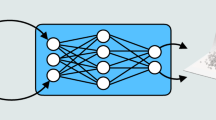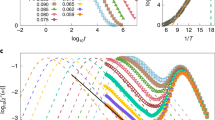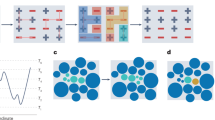Abstract
Supercooled liquids display sluggish dynamics, often attributed to their structural characteristics, yet the underlying mechanism remains elusive. Here we conduct numerical investigations into the structure–dynamics relationship in model glass-forming liquids, with a specific focus on an elementary particle rearrangement mode known as the ‘T1 process’. We discover that the ability of a T1 process to preserve glassy structural order before and after is pivotal towards determining a liquid’s fragility—whether it exhibits super-Arrhenius-like or Arrhenius-like behaviour. If a T1 process disrupts local structural order, it must occur independently without cooperativity, resulting in Arrhenius-like behaviour. By contrast, if it can maintain order, it sequentially propagates from disordered peripheries to the middle of high-structural-order regions, leading to cooperativity and super-Arrhenius-like behaviour. Our study establishes a microscopic link between liquid-structure ordering, dynamic cooperativity and super-Arrhenius-like dynamics, extending the understanding of the structure–dynamics relationships in supercooled liquids.
This is a preview of subscription content, access via your institution
Access options
Access Nature and 54 other Nature Portfolio journals
Get Nature+, our best-value online-access subscription
$32.99 / 30 days
cancel any time
Subscribe to this journal
Receive 12 print issues and online access
$259.00 per year
only $21.58 per issue
Buy this article
- Purchase on SpringerLink
- Instant access to full article PDF
Prices may be subject to local taxes which are calculated during checkout





Similar content being viewed by others
Data availability
All data that support the findings of this study are available in the Article and the Supplementary Information.
Code availability
All codes used for simulation and analysis are available from the corresponding author upon request.
References
Angell, C. A. Formation of glasses from liquids and biopolymers. Science 267, 1924–1935 (1995).
Angell, C. A., Ngai, K. L., McKenna, G. B., McMillan, P. F. & Martin, S. W. Relaxation in glassforming liquids and amorphous solids. J. Appl. Phys. 88, 3113–3157 (2000).
Ediger, M. D. Spatially heterogeneous dynamics in supercooled liquids. Annu. Rev. Phys. Chem. 51, 99–128 (2000).
Debenedetti, P. G. & Stillinger, F. H. Supercooled liquids and the glass transition. Nature 410, 259–267 (2001).
Dyre, J. C. Colloquium: the glass transition and elastic models of glass-forming liquids. Rev. Mod. Phys. 78, 953–972 (2006).
Berthier, L. & Biroli, G. Theoretical perspective on the glass transition and amorphous materials. Rev. Mod. Phys. 83, 587–645 (2011).
Tanaka, H. Bond orientational order in liquids: towards a unified description of water-like anomalies, liquid-liquid transition, glass transition, and crystallization. Eur. Phys. J. E 35, 113 (2012).
Royall, C. P. & Williams, S. R. The role of local structure in dynamical arrest. Phys. Rep. 560, 1–75 (2015).
Hurley, M. M. & Harrowell, P. Kinetic structure of a two-dimensional liquid. Phys. Rev. E 52, 1694–1698 (1995).
Widmer-Cooper, A. & Harrowell, P. Predicting the long-time dynamic heterogeneity in a supercooled liquid on the basis of short-time heterogeneities. Phys. Rev. Lett. 96, 185701 (2006).
Shintani, H. & Tanaka, H. Frustration on the way to crystallization in glass. Nat. Phys. 2, 200–206 (2006).
Coslovich, D. & Pastore, G. Understanding fragility in supercooled Lennard-Jones mixtures. I. Locally preferred structures. J. Chem. Phys. 127, 124504 (2007).
Tanaka, H., Kawasaki, T., Shintani, H. & Watanabe, K. Critical-like behaviour of glass-forming liquids. Nat. Mater. 9, 324–331 (2010).
Xia, C. et al. The structural origin of the hard-sphere glass transition in granular packing. Nat. Commun. 6, 8409 (2015).
Tong, H. & Tanaka, H. Revealing hidden structural order controlling both fast and slow glassy dynamics in supercooled liquids. Phys. Rev. X 8, 011041 (2018).
Tong, H. & Tanaka, H. Structural order as a genuine control parameter of dynamics in simple glass formers. Nat. Commun. 10, 5596 (2019).
Tong, H. & Tanaka, H. Role of attractive interactions in structure ordering and dynamics of glass-forming liquids. Phys. Rev. Lett. 124, 225501 (2020).
Zheng, Z., Ni, R., Wang, Y. & Han, Y. Translational and rotational critical-like behaviors in the glass transition of colloidal ellipsoid monolayers. Sci. Adv. 7, eabd1958 (2021).
Singh, N., Zhang, Z., Sood, A. K., Kob, W. & Ganapathy, R. Intermediate-range order governs dynamics in dense colloidal liquids. Proc. Natl Acad. Sci. USA 120, e2300923120 (2023).
Chandler, D. & Garrahan, J. P. Dynamics on the way to forming glass: bubbles in space-time. Annu. Rev. Phys. Chem. 61, 191–217 (2010).
Kob, W., Donati, C., Plimpton, S. J., Poole, P. H. & Glotzer, S. C. Dynamical heterogeneities in a supercooled Lennard-Jones liquid. Phys. Rev. Lett. 79, 2827–2830 (1997).
Yamamoto, R. & Onuki, A. Dynamics of highly supercooled liquids: heterogeneity, rheology, and diffusion. Phys. Rev. E 58, 3515–3529 (1998).
Sherrington, D., Davison, L., Buhot, A. & Garrahan, J. P. Glassy behaviour in simple kinetically constrained models: topological networks, lattice analogues and annihilation-diffusion. J. Phys. Condens. Matter 14, 1673 (2002).
Langer, J. S. Dynamics and thermodynamics of the glass transition. Phys. Rev. E 73, 041504 (2006).
Eckmann, J.-P. & Procaccia, I. Ergodicity and slowing down in glass-forming systems with soft potentials: no finite-temperature singularities. Phys. Rev. E 78, 011503 (2008).
Bouchbinder, E. & Langer, J. S. Shear-transformation-zone theory of linear glassy dynamics. Phys. Rev. E 83, 061503 (2011).
Zhou, Y. & Milner, S. T. T1 process and dynamics in glass-forming hard-sphere liquids. Soft Matter 11, 2700–2705 (2015).
Socolar, J. E. S., Lubensky, T. C. & Steinhardt, P. J. Phonons, phasons, and dislocations in quasicrystals. Phys. Rev. B 34, 3345–3360 (1986).
Adam, G. & Gibbs, J. H. On the temperature dependence of cooperative relaxation properties in glass-forming liquids. J. Chem. Phys. 43, 139–146 (1965).
Russo, J., Romano, F. & Tanaka, H. Glass forming ability in systems with competing orderings. Phys. Rev. X 8, 021040 (2018).
Donati, C. et al. Stringlike cooperative motion in a supercooled liquid. Phys. Rev. Lett. 80, 2338–2341 (1998).
Bouchaud, J.-P. & Biroli, G. On the Adam-Gibbs-Kirkpatrick-Thirumalai-Wolynes scenario for the viscosity increase in glasses. J. Chem. Phys. 121, 7347–7354 (2004).
Betancourt, B. A. P., Hanakata, P. Z., Starr, F. W. & Douglas, J. F. Quantitative relations between cooperative motion, emergent elasticity, and free volume in model glass-forming polymer materials. Proc. Natl Acad. Sci. USA 112, 2966–2971 (2015).
Kob, W. & Andersen, H. C. Testing mode-coupling theory for a supercooled binary Lennard-Jones mixture. II. Intermediate scattering function and dynamic susceptibility. Phys. Rev. E 52, 4134–4153 (1995).
Böhmer, R., Ngai, K. L., Angell, C. A. & Plazek, D. J. Nonexponential relaxations in strong and fragile glass formers. J. Chem. Phys. 99, 4201–4209 (1993).
Onuki, A. Phase Transition Dynamics (Cambridge Univ. Press, 2002).
Lačević, N., Starr, F. W., Schrøder, T. B. & Glotzer, S. C. Spatially heterogeneous dynamics investigated via a time-dependent four-point density correlation function. J. Chem. Phys. 119, 7372–7387 (2003).
Mosayebi, M., Del Gado, E., Ilg, P. & Öttinger, H. C. Probing a critical length scale at the glass transition. Phys. Rev. Lett. 104, 205704 (2010).
Gilman, J. J. Dislocation mobility in crystals. J. Appl. Phys. 36, 3195–3206 (1965).
Galwey, A. K. & Brown, M. E. A theoretical justification for the application of the Arrhenius equation to kinetics of solid state reactions (mainly ionic crystals). Proc. Royal Soc. Lond. A 450, 501–512 (1995).
Langer, J. S. Ising model of a glass transition. Phys. Rev. E 88, 012122 (2013).
Tanaka, H., Tong, H., Shi, R. & Russo, J. Revealing key structural features hidden in liquids and glasses. Nat. Rev. Phys. 1, 333–348 (2019).
Horbach, J., Kob, W. & Binder, K. Molecular dynamics simulation of the dynamics of supercooled silica. Philos. Mag. B 77, 297–303 (1998).
Horbach, J. & Kob, W. Static and dynamic properties of a viscous silica melt. Phys. Rev. B 60, 3169–3181 (1999).
Shi, R. & Tanaka, H. Impact of local symmetry breaking on the physical properties of tetrahedral liquids. Proc. Natl Acad. Sci. USA 115, 1980–1985 (2018).
Zargar, R., Nienhuis, B., Schall, P. & Bonn, D. Direct measurement of the free energy of aging hard sphere colloidal glasses. Phys. Rev. Lett. 110, 258301 (2013).
Mei, B., Zhuang, B., Lu, Y., An, L. & Wang, Z.-G. Local-average free volume correlates with dynamics in glass formers. J. Phys. Chem. Lett. 13, 3957–3964 (2022).
Scalliet, C., Guiselin, B. & Berthier, L. Thirty milliseconds in the life of a supercooled liquid. Phys. Rev. X 12, 041028 (2022).
Tanaka, H. Roles of liquid structural ordering in glass transition, crystallization, and water’s anomalies. J. NonCryst. Solids X 13, 100076 (2022).
Plimpton, S. Fast parallel algorithms for short-range molecular dynamics. J. Comput. Phys. 117, 1–19 (1995).
Flenner, E. & Szamel, G. Fundamental differences between glassy dynamics in two and three dimensions. Nat. Commun. 6, 7392 (2015).
Shiba, H., Yamada, Y., Kawasaki, T. & Kim, K. Unveiling dimensionality dependence of glassy dynamics: 2D infinite fluctuation eclipses inherent structural relaxation. Phys. Rev. Lett. 117, 245701 (2016).
Illing, B. et al. Mermin–Wagner fluctuations in 2D amorphous solids. Proc. Natl Acad. Sci. USA 114, 1856–1861 (2017).
Vivek, S., Kelleher, C. P., Chaikin, P. M. & Weeks, E. R. Long-wavelength fluctuations and the glass transition in two dimensions and three dimensions. Proc. Natl Acad. Sci. USA 114, 1850–1855 (2017).
Acknowledgements
This work was partially supported by Specially Promoted Research (JP25000002 and JP20H05619) and Scientific Research (A) (JP18H03675) from the Japan Society of the Promotion of Science (JSPS).
Author information
Authors and Affiliations
Contributions
H.T. conceived and supervised the project; S.I. and Y.-C.H. performed numerical simulations. S.I., Y.-C.H. and H.T. discussed the results and wrote the manuscript.
Corresponding author
Ethics declarations
Competing interests
The authors declare no competing interests.
Peer review
Peer review information
Nature Materials thanks Yujie Wang, Lothar Wondraczek and the other, anonymous, reviewer(s) for their contribution to the peer review of this work.
Additional information
Publisher’s note Springer Nature remains neutral with regard to jurisdictional claims in published maps and institutional affiliations.
Extended data
Extended Data Fig. 1 An example of structural characterisation of the 2D nonadditive systems.
A zero-temperature diffraction pattern. The scattering pattern for (η, cB) = (0.65, 0.3) and Q = 10−5.5 reveals a distinct 12-fold symmetry pattern characteristic of a dodecagonal quasi-crystal.
Extended Data Fig. 2 Temperature dependence of the self-intermediate scattering functions for the three liquids.
a, Liquid I. b, Liquid II. c, PHD. See Methods for details on calculating the self-intermediate scattering function Fs(q, t).
Extended Data Fig. 3 Comparison of structure and dynamics obtained from the isoconfigurational ensemble for the ‘fragile’ PHD (a-d, T=0.0024) and the ‘strong’ liquid II (e-h, T=0.018).
a, The spatial distribution of the local structural order parameter \({\Psi }_{6}^{c}\) coarse-grained over its spatial correlation length ξ6 (see the colour bar) (see refs. 15,16 for the meaning of the coarse-graining). b-d, Cage-relative atomic displacements (see the colour bar) during 1τα, 5τα, and 10τα averaged from 300 independent runs starting from the same initial structure as in a.e, The spatial distribution of the local structural order parameter Ψ8 (see the colour bar). f-h, Cage-relative atomic displacements (see the colour bar) during 1τα, 5τα, and 10τα averaged from 300 independent runs starting from the same initial structure as in e. Common features in these two systems include the correspondence between dynamical heterogeneity and the structural order parameter field, as well as their homogenisation as the ordered region gradually becomes disordered over time. After a long time, every atom will have completed structural relaxation with large displacements. We can see that dynamic heterogeneity is much longer-lived for liquid II than for PHD.
Extended Data Fig. 4 The spatial decay of the correlation of structural order parameters.
a-c, The temperature dependences of g12(r)/g(r), g8(r)/g(r), and g6(r)/g(r) for liquid I, liquid II, and PHD, respectively. The dashed lines represent fits to the OZ functions, from which we determine the structural correlation length ξ12, ξ8, and ξ6. We can see the increase of the structural correlation length upon cooling for the three liquids. The correlation lengths estimated in this manner are presented in Fig. 2f-h.
Extended Data Fig. 5 Temperature dependence of dynamic heterogeneities.
a-c, The temperature dependences of χ4 (t) of liquid I, liquid II, and PHD, respectively. In all systems, χ4 (t) exhibits a rapid increase with decreasing temperature. This behaviour is noticeable even for liquid II, which is a strong liquid. It is uncommon to observe such pronounced dynamic heterogeneity in strong liquids. Notably, the peak magnitudes of χ4 (t) of liquid II are smaller than those for liquid I and PHD. This trend aligns with the steep decrease in the stretching exponent, β, for liquid II upon cooling (see Fig. 1f in the main text). The underlying reason for this seemingly counterintuitive result is explained in the main text. d-f, The temperature changes of the q-dependence of S4(τ4) for liquid I, liquid II, and PHD, respectively. The solid curves represent fits of the Ornstein-Zernike correlation function to the data, allowing us to determine ξdyn.
Extended Data Fig. 6 The non-Gaussian nature of particle diffusion.
a-c, The temperature dependences of the non-Gaussian parameter α2 (t) for liquid I, liquid II, and PHD, respectively. The peak of α2 (t) shows a sharp increase with decreasing temperature in all three systems, indicating the enhancement of dynamic heterogeneity.
Extended Data Fig. 7 Atomic-scale mechanism of structural relaxation for a locally favoured structure in fragile liquids (liquid I and PHD).
a-c, Liquid I. a, Depiction of an LFS motif comprised of 8 red particles exhibiting a pentagonal shape (marked by orange lines). Each particle is labelled with numbers 1-8 to monitor their movements. b, Illustration of the LFS transformation into an intermediate disordered state by two T1 processes (yellow triangles). Each T1 process involves four particles breaking old bonds and creating new ones. c, Formation of a new LFS (orange pentagon) through two successive T1 processes (yellow triangles). The centre of the new LFS retains 6 old neighbours and gains a new neighbour, resulting in the transformation from the initial loose pentagon-shaped arrangement to a new, tight-packed LFS. Therefore, the old LFS shown in panel a undergoes a rotation to transform into the new LFS through this particle rearrangement process. B particles are shown in blue and large, while A particles are depicted in green for better visualisation. d-f, PHD. d, Depiction of an LFS motif with hexatic ordering. Each particle is labelled with numbers 1–9 to track their movements. e, Occurrence of a T1 process among atoms 1–2–3–7 from panel d, creating an intermediate disordered state. f, Another T1 process among atoms 1–4–8–9 from panel e. The central atom (red) escapes from its initial cage formed by atoms 2–3–4–5–6–7 (see panel d) while maintaining the order of 4–5–7–3–8–9 during sequential T1 events. In this polydisperse system, atoms are represented as equal-sized for simplicity in visualisation.
Extended Data Fig. 8 Phason-flip-like particle motion observed in liquid I.
a, Visualization of particle motion in liquid I at T=0.041 over a time interval Δt = 1.2. Filled red and black circles represent A and B particles at t=0, whereas open red and black circles represent their positions at t=1.2. The particle motion of 6 particles is depicted by a red-shaded combined square and triangle at t=0 and a white-shaded one at t=1.2. This particle motion is analogous to the phason-flip motion observed in a 12-fold quasi-crystal. b, Decomposition of the phason-flip-like motion (top row) into two T1 processes (two bottom rows). Three particles mainly move in the process, as indicated by arrows, leading to the occurrence of two T1 processes. In the right images, newly formed and broken bonds are represented by solid and broken lines, respectively.
Extended Data Fig. 9 Comparison of the self-intermediate scattering functions Fs(q, t) between absolute and cage-relative particle motion at T=0.00225 for PHD.
The time when Fs(q, t) = 1/e is defined as \({\tau }_{ \alpha }^{{\rm{abs}}}(\approx 440)\) and τα (≈ 104) for absolute and cage-relative motion, respectively. Therefore, at this temperature, \({\tau }_{ \alpha }\cong 23{\tau }_{\rm \alpha }^{{\rm{abs}}}\). The former is influenced by Mermin-Wagner-type fluctuations, whereas the latter is free from such effects.
Supplementary information
Supplementary Information
Supplementary Notes 1 and 2, Figs. 1 and 2 and references.
Supplementary Video 1
Dynamics and T1 processes in 2D PHD supercooled liquid.
Supplementary Video 2
Dynamics and T1 processes in 3D PHS supercooled liquid.
Rights and permissions
Springer Nature or its licensor (e.g. a society or other partner) holds exclusive rights to this article under a publishing agreement with the author(s) or other rightsholder(s); author self-archiving of the accepted manuscript version of this article is solely governed by the terms of such publishing agreement and applicable law.
About this article
Cite this article
Ishino, S., Hu, YC. & Tanaka, H. Microscopic structural origin of slow dynamics in glass-forming liquids. Nat. Mater. 24, 268–277 (2025). https://doi.org/10.1038/s41563-024-02068-8
Received:
Accepted:
Published:
Issue date:
DOI: https://doi.org/10.1038/s41563-024-02068-8



